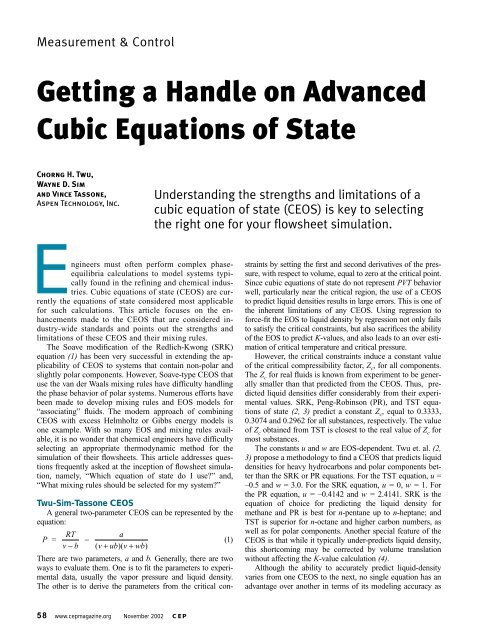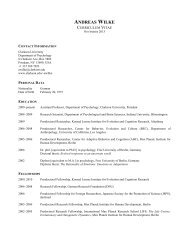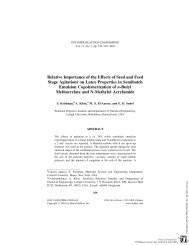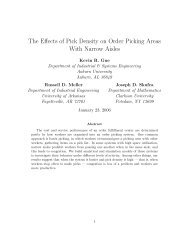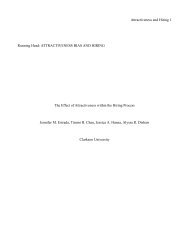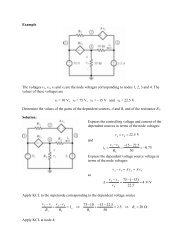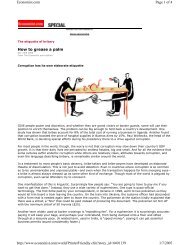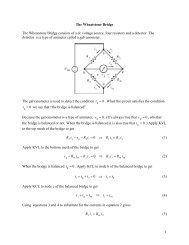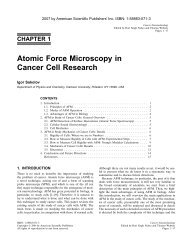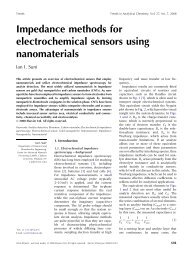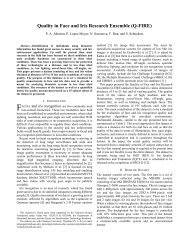Getting a Handle on Advanced Cubic Equations of State
Getting a Handle on Advanced Cubic Equations of State
Getting a Handle on Advanced Cubic Equations of State
You also want an ePaper? Increase the reach of your titles
YUMPU automatically turns print PDFs into web optimized ePapers that Google loves.
Measurement & C<strong>on</strong>trol<br />
<str<strong>on</strong>g>Getting</str<strong>on</strong>g> a <str<strong>on</strong>g>Handle</str<strong>on</strong>g> <strong>on</strong> <strong>Advanced</strong><br />
<strong>Cubic</strong> Equati<strong>on</strong>s <strong>of</strong> <strong>State</strong><br />
Chorng H. Twu,<br />
Wayne D. Sim<br />
and Vince Tass<strong>on</strong>e,<br />
Aspen Technology, Inc.<br />
E<br />
ngineers must <strong>of</strong>ten perform complex phaseequilibria<br />
calculati<strong>on</strong>s to model systems typically<br />
found in the refining and chemical industries.<br />
<strong>Cubic</strong> equati<strong>on</strong>s <strong>of</strong> state (CEOS) are currently<br />
the equati<strong>on</strong>s <strong>of</strong> state c<strong>on</strong>sidered most applicable<br />
for such calculati<strong>on</strong>s. This article focuses <strong>on</strong> the enhancements<br />
made to the CEOS that are c<strong>on</strong>sidered industry-wide<br />
standards and points out the strengths and<br />
limitati<strong>on</strong>s <strong>of</strong> these CEOS and their mixing rules.<br />
The Soave modificati<strong>on</strong> <strong>of</strong> the Redlich-Kw<strong>on</strong>g (SRK)<br />
equati<strong>on</strong> (1) has been very successful in extending the applicability<br />
<strong>of</strong> CEOS to systems that c<strong>on</strong>tain n<strong>on</strong>-polar and<br />
slightly polar comp<strong>on</strong>ents. However, Soave-type CEOS that<br />
use the van der Waals mixing rules have difficulty handling<br />
the phase behavior <strong>of</strong> polar systems. Numerous efforts have<br />
been made to develop mixing rules and EOS models for<br />
“associating” fluids. The modern approach <strong>of</strong> combining<br />
CEOS with excess Helmholtz or Gibbs energy models is<br />
<strong>on</strong>e example. With so many EOS and mixing rules available,<br />
it is no w<strong>on</strong>der that chemical engineers have difficulty<br />
selecting an appropriate thermodynamic method for the<br />
simulati<strong>on</strong> <strong>of</strong> their flowsheets. This article addresses questi<strong>on</strong>s<br />
frequently asked at the incepti<strong>on</strong> <strong>of</strong> flowsheet simulati<strong>on</strong>,<br />
namely, “Which equati<strong>on</strong> <strong>of</strong> state do I use?” and,<br />
“What mixing rules should be selected for my system?”<br />
Twu-Sim-Tass<strong>on</strong>e CEOS<br />
A general two-parameter CEOS can be represented by the<br />
equati<strong>on</strong>:<br />
P<br />
=<br />
RT<br />
v−b −<br />
a<br />
( v+ ub) ( v+ wb)<br />
There are two parameters, a and b. Generally, there are two<br />
ways to evaluate them. One is to fit the parameters to experimental<br />
data, usually the vapor pressure and liquid density.<br />
The other is to derive the parameters from the critical c<strong>on</strong>-<br />
58 www.cepmagazine.org November 2002 CEP<br />
Understanding the strengths and limitati<strong>on</strong>s <strong>of</strong> a<br />
cubic equati<strong>on</strong> <strong>of</strong> state (CEOS) is key to selecting<br />
the right <strong>on</strong>e for your flowsheet simulati<strong>on</strong>.<br />
() 1<br />
straints by setting the first and sec<strong>on</strong>d derivatives <strong>of</strong> the pressure,<br />
with respect to volume, equal to zero at the critical point.<br />
Since cubic equati<strong>on</strong>s <strong>of</strong> state do not represent PVT behavior<br />
well, particularly near the critical regi<strong>on</strong>, the use <strong>of</strong> a CEOS<br />
to predict liquid densities results in large errors. This is <strong>on</strong>e <strong>of</strong><br />
the inherent limitati<strong>on</strong>s <strong>of</strong> any CEOS. Using regressi<strong>on</strong> to<br />
force-fit the EOS to liquid density by regressi<strong>on</strong> not <strong>on</strong>ly fails<br />
to satisfy the critical c<strong>on</strong>straints, but also sacrifices the ability<br />
<strong>of</strong> the EOS to predict K-values, and also leads to an over estimati<strong>on</strong><br />
<strong>of</strong> critical temperature and critical pressure.<br />
However, the critical c<strong>on</strong>straints induce a c<strong>on</strong>stant value<br />
<strong>of</strong> the critical compressibility factor, Z c , for all comp<strong>on</strong>ents.<br />
The Z c for real fluids is known from experiment to be generally<br />
smaller than that predicted from the CEOS. Thus, predicted<br />
liquid densities differ c<strong>on</strong>siderably from their experimental<br />
values. SRK, Peng-Robins<strong>on</strong> (PR), and TST equati<strong>on</strong>s<br />
<strong>of</strong> state (2, 3) predict a c<strong>on</strong>stant Z c , equal to 0.3333,<br />
0.3074 and 0.2962 for all substances, respectively. The value<br />
<strong>of</strong> Z c obtained from TST is closest to the real value <strong>of</strong> Z c for<br />
most substances.<br />
The c<strong>on</strong>stants u and w are EOS-dependent. Twu et. al. (2,<br />
3) propose a methodology to find a CEOS that predicts liquid<br />
densities for heavy hydrocarb<strong>on</strong>s and polar comp<strong>on</strong>ents better<br />
than the SRK or PR equati<strong>on</strong>s. For the TST equati<strong>on</strong>, u =<br />
–0.5 and w = 3.0. For the SRK equati<strong>on</strong>, u = 0, w = 1. For<br />
the PR equati<strong>on</strong>, u = –0.4142 and w = 2.4141. SRK is the<br />
equati<strong>on</strong> <strong>of</strong> choice for predicting the liquid density for<br />
methane and PR is best for n-pentane up to n-heptane; and<br />
TST is superior for n-octane and higher carb<strong>on</strong> numbers, as<br />
well as for polar comp<strong>on</strong>ents. Another special feature <strong>of</strong> the<br />
CEOS is that while it typically under-predicts liquid density,<br />
this shortcoming may be corrected by volume translati<strong>on</strong><br />
without affecting the K-value calculati<strong>on</strong> (4).<br />
Although the ability to accurately predict liquid-density<br />
varies from <strong>on</strong>e CEOS to the next, no single equati<strong>on</strong> has an<br />
advantage over another in terms <strong>of</strong> its modeling accuracy as
l<strong>on</strong>g as the same alpha functi<strong>on</strong> (for pure-comp<strong>on</strong>ent vapor<br />
pressure correlati<strong>on</strong>) and the same mixing rules (for mixtureproperty<br />
correlati<strong>on</strong>) are used (5). Since the ability <strong>of</strong> any<br />
CEOS to predict phase equilibria <strong>of</strong> mixtures depends <strong>on</strong> the<br />
alpha functi<strong>on</strong> and the mixing rule, these two elements will be<br />
the focus <strong>of</strong> the remainder <strong>of</strong> this article.<br />
Alpha functi<strong>on</strong>s for cubic equati<strong>on</strong>s <strong>of</strong> state<br />
The accurate predicti<strong>on</strong> <strong>of</strong> K-values from any CEOS requires<br />
an equally accurate predicti<strong>on</strong> <strong>of</strong> pure-comp<strong>on</strong>ent<br />
vapor pressures, which depends <strong>on</strong> the development <strong>of</strong> an appropriate<br />
alpha functi<strong>on</strong> α(T). The first CEOS to be successfully<br />
applied to the calculati<strong>on</strong> <strong>of</strong> thermodynamic properties<br />
for the vapor phase was the modified form <strong>of</strong> the van der<br />
Waals equati<strong>on</strong> by Redlich and Kw<strong>on</strong>g (6), who incorporated<br />
temperature dependence into the a term:<br />
P<br />
=<br />
RT<br />
v−b The success <strong>of</strong> the Redlich-Kw<strong>on</strong>g (RK) equati<strong>on</strong> stimulated<br />
numerous researchers to propose various correlati<strong>on</strong>s for improving<br />
the predicti<strong>on</strong> <strong>of</strong> vapor pressure. Wils<strong>on</strong> (7) first introduced<br />
a general form <strong>of</strong> temperature dependence <strong>of</strong> the a<br />
parameter in the RK equati<strong>on</strong> in 1964:<br />
a(T) = α(T)a c<br />
−<br />
05 .<br />
aT<br />
vv ( + b)<br />
where a c is the value <strong>of</strong> a at the critical point. In 1966, Wils<strong>on</strong><br />
(8) expressed α(T) as a functi<strong>on</strong> <strong>of</strong> the reduced temperature,<br />
T r = T/T c , and the acentric factor ω as follows:<br />
α(T) = T r + (1.57 + 1.62ω)(1 – T r ) (4)<br />
However, since the error <strong>of</strong> predicted vapor pressure from Eq.<br />
4 is quite large, Wils<strong>on</strong>’s functi<strong>on</strong> did not find widespread<br />
use. The α(T) functi<strong>on</strong> that did find its way into the mainstream<br />
was proposed by Soave in 1972. He developed a linear<br />
equati<strong>on</strong> for α as a functi<strong>on</strong> <strong>of</strong> temperature by plotting α 0.5<br />
against T r 0.5 at a c<strong>on</strong>stant ω:<br />
α(T) = (1 + m(1 – T r 0.5)) 2 (5)<br />
The m parameter is obtained by forcing the equati<strong>on</strong> to reproduce<br />
vapor pressures for light hydrocarb<strong>on</strong>s corresp<strong>on</strong>ding to<br />
C 1 through C 10 at T r = 0.7, and is correlated as a functi<strong>on</strong> <strong>of</strong> ω:<br />
m = 0.480 + 1.57ω – 0.176ω 2 (6)<br />
( 2)<br />
Soave’s development <strong>of</strong> Eqs. 5 and 6 represented a great step<br />
forward in the practical applicati<strong>on</strong> <strong>of</strong> CEOS. The Soave α(T),<br />
(or Eq. 5) defined as a functi<strong>on</strong> <strong>of</strong> both T r and ω, is good for<br />
predicting the vapor pressures <strong>of</strong> hydrocarb<strong>on</strong>s at temperatures<br />
above their normal boiling points, but not at c<strong>on</strong>diti<strong>on</strong>s above<br />
the critical point, since the functi<strong>on</strong> does not decrease m<strong>on</strong>o-<br />
(3)<br />
Nomenclature<br />
a, b = CEOS parameters<br />
a * , b * = reduced parameters <strong>of</strong> a and b<br />
A =Helmholtz energy<br />
c1 ,c2 ,c3 = c<strong>on</strong>stants in α(T) functi<strong>on</strong> (Eq. 14, 15)<br />
C1 = c<strong>on</strong>stant at infinite pressure<br />
Cr = c<strong>on</strong>stant at zero pressure<br />
Cv0 = functi<strong>on</strong> at zero pressure<br />
G = Gibbs energy<br />
k<br />
ij , k ij<br />
= binary interacti<strong>on</strong> parameter<br />
= binary interacti<strong>on</strong> parameter<br />
l ij<br />
m = parameter in Soave’s equati<strong>on</strong> for α(T), Eq. 5<br />
n = parameter in Soave’s expanded equati<strong>on</strong> for α(T), Eq. 7<br />
L, M, N = parameters in the Twu α functi<strong>on</strong><br />
P = pressure<br />
R = ideal gas c<strong>on</strong>stant<br />
r = c<strong>on</strong>stant reduced liquid volume at zero-pressure<br />
T = temperature<br />
u, w = CEOS c<strong>on</strong>stants<br />
v = molar volume<br />
v 0 * = reduced liquid volume at zero pressure<br />
V = total volume<br />
x = mole fracti<strong>on</strong> <strong>of</strong> comp<strong>on</strong>ent i in liquid phase<br />
i<br />
Z = compressibility facto<br />
Greek letters<br />
α = CEOS alpha functi<strong>on</strong><br />
δ = parameter used to define τ<br />
ω = acentric factor<br />
τ = parameter used in TST excess Gibbs energy model<br />
Subscripts<br />
0 = zero pressure<br />
∞ = infinite pressure<br />
c = critical property<br />
i, j ,k = property <strong>of</strong> comp<strong>on</strong>ent i, j, k<br />
ij, ji = interacti<strong>on</strong> property between comp<strong>on</strong>ents i and j<br />
ik, ki = interacti<strong>on</strong> property between comp<strong>on</strong>ents i and k<br />
r = reduced property<br />
vdw = van der Waals<br />
Superscripts<br />
* = reduced property<br />
E = excess property<br />
(0) and (1) = denotes value <strong>of</strong> α when ω = 0 and ω = 1<br />
† Any c<strong>on</strong>sistent set <strong>of</strong> units is acceptable.<br />
t<strong>on</strong>ically with increasing temperature.<br />
Another shortcoming <strong>of</strong> Soave’s α(T) functi<strong>on</strong> is that the<br />
calculated vapor pressures tend to diverge from the experimental<br />
<strong>on</strong>es at low temperatures. Therefore, Soave proposed a<br />
new α(T) functi<strong>on</strong> to improve vapor-pressure predicti<strong>on</strong> by<br />
expanding Eq. 5 as follows (9):<br />
α(T) = 1 + m(1 – T r )+n(1 – T r 0.5) 2 (7)<br />
where m and n are obtained by correlating vapor-pressure values<br />
generated by the Lee-Kesler EOS:<br />
m = 0.484 + 1.515ω – 0.44ω 2 (8)<br />
n = 2.756m – 0.700 (9)<br />
CEP November 2002 www.cepmagazine.org 59
Measurement & C<strong>on</strong>trol<br />
Unfortunately, the accuracy <strong>of</strong> predicting<br />
vapor pressure from Soave’s new α(T)<br />
was no better than the original <strong>on</strong>e, and<br />
c<strong>on</strong>sequently, was never accepted for applicati<strong>on</strong>.<br />
Numerous investigators have<br />
tried to improve Soave’s alpha functi<strong>on</strong><br />
by either altering the parameters or<br />
adding extra terms. But as l<strong>on</strong>g as the<br />
same or a similar form <strong>of</strong> the alpha functi<strong>on</strong><br />
is used, and the same approach as<br />
Soave is applied (i.e., plotting α 0.5 vs.<br />
T r 0.5), the functi<strong>on</strong>’s inherent weaknesswill<br />
not be overcome.<br />
Better vapor pressure predicti<strong>on</strong><br />
Twu et. al. (10, 11) developed a new<br />
methodology to improve the accuracy <strong>of</strong> the<br />
vapor-pressure predicti<strong>on</strong> from a CEOS.<br />
They found that the alpha functi<strong>on</strong> is a linear<br />
functi<strong>on</strong> <strong>of</strong> the acentric factor at a c<strong>on</strong>stant<br />
reduced temperature.<br />
α = α (0) + ω(α (1) – α (0) ) (10)<br />
α ( ) ( ) 0 N M − 1 L ( 1−<br />
T )<br />
=<br />
e r<br />
T r<br />
( 1) ( 1)<br />
N M<br />
α () ( ) ( 1) ( 1) ( 1)<br />
1 N M − 1 L ( 1−<br />
T )<br />
=<br />
e r<br />
T r<br />
( 0) ( 0) ( 0 )<br />
( 0 ) ( 0 )<br />
N M<br />
( 11)<br />
( 12)<br />
The superscripts (0) and (1) in Eqs. 10, 11 and 12 are c<strong>on</strong>sistent<br />
with the definiti<strong>on</strong> <strong>of</strong> the acentric factor at ω = 0 and ω<br />
=1, respectively. In other words, these two alpha functi<strong>on</strong>s are<br />
forced to pass through the saturated vapor pressure at T r = 0.7<br />
for ω = 0 and ω = 1, respectively.<br />
Twu et. al. used the latest data from the DIPPR (12) databank<br />
to generate the values <strong>of</strong> α (0) and α (1) for SRK, PR and<br />
TST cubic equati<strong>on</strong>s <strong>of</strong> state. Tables 1–3 show the L, M, and N<br />
values used with Eqs. 11 and 12 for SRK, PR and TST CEOS,<br />
respectively. The advantage <strong>of</strong> having a linear acentric factor is<br />
that <strong>on</strong>e can reliably extrapolate its value for heavy hydrocarb<strong>on</strong>s.<br />
The new generalized α(T) functi<strong>on</strong> for SRK, PR and<br />
TST, in Eqs. 10–12, allows the accurate predicti<strong>on</strong> <strong>of</strong> vaporpressure<br />
data from the triple point to the critical point for light<br />
or heavy hydrocarb<strong>on</strong>s using any <strong>of</strong> these EOS.<br />
Although the Twu alpha functi<strong>on</strong> menti<strong>on</strong>ed above works<br />
very well for n<strong>on</strong>-polar comp<strong>on</strong>ents, it is generally not suitable<br />
for polar comp<strong>on</strong>ents. In an attenpt to resolve this difficulty,<br />
Soave (13) presents a two-parameter alpha functi<strong>on</strong>:<br />
α(T) = 1 + (1 – T r )(m + n/T r ) (13)<br />
where m and n are empirical c<strong>on</strong>stants that are fitted to the<br />
vapor pressure <strong>of</strong> the comp<strong>on</strong>ent <strong>of</strong> interest, and are not related<br />
to previously menti<strong>on</strong>ed m and n c<strong>on</strong>stants. Eq. 13 fits<br />
vapor pressure quite well, but the functi<strong>on</strong> can become nega-<br />
60 www.cepmagazine.org November 2002 CEP<br />
Table 1.<br />
Tr ≤ 1 Tr > 1<br />
α Parameter α (0) α (1) α (0) α (1)<br />
L 0.544000 0.544306 0.379919 0.0319134<br />
M 1.01309 0.802404 5.67342 1.28756<br />
N 0.935995 3.10835 –0.200000 –8.000000<br />
The L, M and N databank <strong>of</strong> the generalized alpha functi<strong>on</strong> for Eqs. 11 and 12 with the<br />
Soave-Redlich-Kw<strong>on</strong>g EOS for subcritical and supercritical c<strong>on</strong>diti<strong>on</strong>s.<br />
Table 2.<br />
Tr ≤ 1 Tr > 1<br />
α Parameter α (0) α (1) α (0) α (1)<br />
L 0.272838 0.625701 0.373949 0.0239035<br />
M 0.924779 0.792014 4.73020 1.24615<br />
N 1.19764 2.46022 –0.200000 –8.000000<br />
The L, M and N databank <strong>of</strong> the generalized alpha functi<strong>on</strong> for Eqs. 11 and 12 with the<br />
Peng-Robins<strong>on</strong> EOS for subcritical and supercritical c<strong>on</strong>diti<strong>on</strong>s.<br />
Table 3.<br />
Tr ≤ 1 Tr > 1<br />
α Parameter α (0) α (1) α (0) α (1)<br />
L 0.196545 0.704001 0.358826 0.0206444<br />
M 0.906437 0.790407 4.23478 1.22942<br />
N 1.26251 2.13086 –0.200000 –8.000000<br />
The L, M and N databank <strong>of</strong> the generalized alpha functi<strong>on</strong> for Eqs. 11 and 12 with the<br />
Twu-Sim-Tass<strong>on</strong>e EOS for subcritical and supercritical c<strong>on</strong>diti<strong>on</strong>s.<br />
tive at high temperatures. Since the alpha functi<strong>on</strong> represents<br />
the attractive forces, it is physically incorrect for it to be negative.<br />
Mathias (14) and Mathias and Copeman (15) proposed<br />
α(T) functi<strong>on</strong>s similar to Soave’s (Eq. 5). Mathias’ α(T) functi<strong>on</strong><br />
is expressed as:<br />
α(T) = (1 + c 1 (1 – T r 0.5) + c 2 (1 – T r ) (0.7 – T r 0.5)) 2 (14)<br />
while Mathias and Copeman’s α(Τ) functi<strong>on</strong> takes the form:<br />
α(T) = (1 + c 1 (1 – T r 0.5) + c 2 (1 – T r 0.5) 2 + c 3 (1 – T r 0.5) 3 ) 2 (15)<br />
Both functi<strong>on</strong>s increase with increasing temperature at the supercritical<br />
regi<strong>on</strong>. To overcome this difficulty, a sec<strong>on</strong>d correlati<strong>on</strong><br />
for the α(T) functi<strong>on</strong> at temperatures higher than the T c<br />
is <strong>of</strong>ten required. However, using a sec<strong>on</strong>d correlati<strong>on</strong> creates<br />
a disc<strong>on</strong>tinuity in these alpha functi<strong>on</strong>s at the critical point<br />
and produces deviati<strong>on</strong>s in the predicted enthalpies.<br />
Melhem et. al. (16) proposed a similar, but logarithmic<br />
form <strong>of</strong> α(T):<br />
α(T) = exp[1 + c 1 (1 – T r 0.5) + c 2 (1 – T r 0.5)] 2 (16)<br />
The accuracy <strong>of</strong> vapor pressure regressed from this model is<br />
not as good as that for the other functi<strong>on</strong>s menti<strong>on</strong>ed above.<br />
Twu (17) derived α(T) from a probability distributi<strong>on</strong>:<br />
NM<br />
N( M − 1) L ( 1−<br />
T ) r<br />
r<br />
α ( T) = T e<br />
( 17)<br />
Eq. 17 has three parameters, L, M and N, which, unlike those<br />
in Tables 1–3, are unique for each comp<strong>on</strong>ent and are determined<br />
from the regressi<strong>on</strong> <strong>of</strong> pure-comp<strong>on</strong>ent vapor-pressure<br />
data. The authors have set up databanks for L, M and N for a
wide range <strong>of</strong> comp<strong>on</strong>ents, which can be obtained by c<strong>on</strong>tacting<br />
the authors directly. Twu’s α(T) functi<strong>on</strong> has been found<br />
to be more accurate than other α(T) functi<strong>on</strong>s found in literature<br />
for predicting vapor pressures for polar and n<strong>on</strong>-polar<br />
comp<strong>on</strong>ents at temperatures ranging from the triple point to<br />
the critical point. Using the comp<strong>on</strong>ent-dependent parameters,<br />
the accuracy <strong>of</strong> reproducing the vapor pressure from Eq.<br />
17 is within experimental error given in DIPPR.<br />
Twu’s α(T) functi<strong>on</strong> has some unique features. Fluids such<br />
as hydrogen exhibit a maximum alpha at low temperatures<br />
(about 19 K). Twu’s α(T) functi<strong>on</strong> accurately describes this<br />
behavior and is the <strong>on</strong>ly functi<strong>on</strong> so far that shows this maximum<br />
at low temperature. In additi<strong>on</strong>, it is c<strong>on</strong>tinuous at the<br />
critical point for all comp<strong>on</strong>ents and extrapolates very well to<br />
supercritical c<strong>on</strong>diti<strong>on</strong>s without exhibiting abnormal characteristics,<br />
such as increasing with increasing temperature.<br />
Due to the accuracy and wide temperature range <strong>of</strong> applicati<strong>on</strong><br />
<strong>of</strong> the advanced Twu α(T) functi<strong>on</strong>s (Eqs. 10, 11, 12 and<br />
17) for predicting vapor pressures when used in the SRK, PR<br />
and TST equati<strong>on</strong>s <strong>of</strong> state, these equati<strong>on</strong>s have been selected<br />
for use in the SRK, PR and TST models as follows. For<br />
petroleum fracti<strong>on</strong>s and comp<strong>on</strong>ents that do not have vaporpressure<br />
data available, Eqs. 10, 11 and 12 should be used. For<br />
all comp<strong>on</strong>ents that do have vapor-pressure data available, Eq.<br />
17 can be used.<br />
van der Waals mixing rules<br />
In additi<strong>on</strong> to using an appropriate α(T) functi<strong>on</strong> for the<br />
accurate predicti<strong>on</strong> <strong>of</strong> vapor pressure, the ability <strong>of</strong> a CEOS to<br />
correlate and predict phase equilibria <strong>of</strong> mixtures depends<br />
str<strong>on</strong>gly up<strong>on</strong> the mixing rule applied. The most comm<strong>on</strong>ly<br />
used method to extend equati<strong>on</strong>s <strong>of</strong> state to a n<strong>on</strong>-polar mixture<br />
is to use the van der Waals <strong>on</strong>e-fluid mixing rules:<br />
a = ∑ ∑ x x a a 1−k i<br />
where kij is the binary interacti<strong>on</strong> parameter that is obtained<br />
from the regressi<strong>on</strong> <strong>of</strong> vapor-liquid equilibrium data. The van<br />
der Waals mixing rules are capable <strong>of</strong> accurately representing<br />
vapor-liquid equilibria using <strong>on</strong>ly <strong>on</strong>e binary-interacti<strong>on</strong> parameter<br />
for n<strong>on</strong>-polar or slightly polar systems. However,<br />
many mixtures <strong>of</strong> interest in the chemical industry c<strong>on</strong>tain<br />
str<strong>on</strong>gly polar or associating comp<strong>on</strong>ents. One way to modify<br />
the van der Waals mixing rules so that they can better describe<br />
polar systems is to use the asymmetric kij for the a parameter,<br />
as developed by Twu et. al. (17):<br />
a = ∑ ∑ xixj aa i j ( 1−kij)+ i<br />
j<br />
b = x x<br />
⎡1<br />
∑ ∑ i j b + b<br />
i j ⎣⎢ 2<br />
j<br />
i j<br />
( )<br />
i j ij<br />
( i j)<br />
⎤<br />
⎦⎥<br />
( ) ( − )<br />
⎡<br />
∑ x ⎢∑<br />
x aa k k<br />
i ⎣ j<br />
i j i j ji ij<br />
⎤<br />
⎥<br />
⎦<br />
16 13 3<br />
/<br />
( 18)<br />
( 19)<br />
( 20)<br />
Eq. 20 has two adjustable parameters, k ij and k ji . Generally,<br />
they are not equal. The use <strong>of</strong> an asymmetric definiti<strong>on</strong> <strong>of</strong> k ij<br />
in the van der Waals mixing rule <strong>of</strong> Eq. 20 is similar to the<br />
asymmetric parameters A ij and A ij used in the excess Gibbs<br />
energy (G E ) mixing rule <strong>of</strong> the NRTL model. If k ij = k ij , Eq. 20<br />
reduces to the van der Waals mixing rule (Eq. 18).<br />
The modified van der Waals mixing rule (Eq. 20) provides<br />
accurate correlati<strong>on</strong> <strong>of</strong> complex mixtures, including highly<br />
n<strong>on</strong>-ideal systems that previously could <strong>on</strong>ly be correlated by<br />
activity-coefficient models. However, Eq. 20 no l<strong>on</strong>ger satisfies<br />
the sec<strong>on</strong>d virial coefficient.<br />
Hur<strong>on</strong>-Vidal infinite-pressure mixing rules<br />
Since the van der Waals mixing rules are applicable <strong>on</strong>ly<br />
to mixtures whose excess Gibbs energy can be approximated<br />
by the regular soluti<strong>on</strong> theory, quite a few new mixing rules<br />
have been recently developed based <strong>on</strong> appropriate excess<br />
energy models. Hur<strong>on</strong> and Vidal (18) successfully formulated<br />
a new EOS parameter a by assuming that the excess<br />
Gibbs energy at infinite pressure, GE ∞ , which is derived from<br />
a CEOS, is equal to GE derived from a liquid-activity-coefficient<br />
model. They also assumed that the liquid volume at infinite<br />
pressure equals the EOS co-volume, b. The Hur<strong>on</strong>-<br />
Vidal derivati<strong>on</strong> led to the following equati<strong>on</strong> for a * :<br />
The parameters a * and b * a b x<br />
in Eq. 21 are defined as:<br />
a<br />
* * ⎡ *<br />
i<br />
= ⎢∑<br />
i *<br />
⎣ i bi 1 G<br />
+<br />
⎛ ∞ ⎞ ⎤<br />
C ⎝ RT ⎠ ⎥<br />
1 ⎦<br />
( 21)<br />
a * = Pa/R 2 T 2 and b * = Pb/RT (21a, b)<br />
The Hur<strong>on</strong>-Vidal approach uses the c<strong>on</strong>venti<strong>on</strong>al linear<br />
mixing rule for the b parameter:<br />
b = xx<br />
⎡1<br />
∑ ∑ i j b i + b<br />
⎤<br />
( j)<br />
i j ⎣⎢ 2 ⎦⎥<br />
The C1 in Eq. 21 is a c<strong>on</strong>stant, and is defined as:<br />
E<br />
( 22)<br />
1 w<br />
C =−<br />
⎛1+<br />
⎞<br />
1<br />
ln<br />
( 23)<br />
( w−u) ⎝ 1 + u ⎠<br />
where u and w are EOS-dependent c<strong>on</strong>stants used to represent<br />
a particular two-parameter CEOS. For example, u = –0.5 and<br />
w = 3.0 for the TST CEOS.<br />
Although Hur<strong>on</strong> and Vidal presented their model more than<br />
two decades ago, their mixing rule is not widely used due to lack<br />
<strong>of</strong> parameters available in literature for the excess Gibbs energy<br />
at infinite pressure and the inability to accurately describe n<strong>on</strong>polar<br />
hydrocarb<strong>on</strong> mixtures and to satisfy the quadratic compositi<strong>on</strong><br />
dependence <strong>of</strong> the sec<strong>on</strong>d virial coefficient.<br />
W<strong>on</strong>g-Sandler infinite-pressure mixing rules<br />
The Hur<strong>on</strong>-Vidal approach requires the excess volume, V E ,<br />
to be zero and EOS parameter b to be calculated via a linear<br />
mixing rule. To allow the use <strong>of</strong> a different mixing rule for parameter<br />
b, W<strong>on</strong>g and Sandler (19) developed a model equating<br />
CEP November 2002 www.cepmagazine.org 61
Measurement & C<strong>on</strong>trol<br />
the excess Helmholtz energy at infinite pressure from a CEOS<br />
to excess Helmholtz energy calculated from an activity coefficient<br />
model, and they c<strong>on</strong>strained the EOS parameters a and b<br />
to satisfy the sec<strong>on</strong>d-virial-coefficient c<strong>on</strong>diti<strong>on</strong>:<br />
a b x a<br />
E<br />
* * ⎡ *<br />
i 1 A<br />
= ∑ i * +<br />
⎛ ∞ ⎞ ⎤<br />
⎢<br />
( )<br />
⎣ i biC ⎝ RT ⎠ ⎥<br />
24<br />
1 ⎦<br />
n n a<br />
xx<br />
⎛ ij<br />
∑ ∑ i j bij<br />
−<br />
⎞<br />
j ⎝ RT ⎠<br />
i b =<br />
a*<br />
1 − *<br />
b<br />
The W<strong>on</strong>g-Sandler model introduced a binary interacti<strong>on</strong> parameter,<br />
k<br />
ij , to correct the assumpti<strong>on</strong> that the excess<br />
Helmholtz free energy at infinite pressure can be approximated<br />
by the excess Gibbs free energy at low pressure:<br />
b<br />
ij<br />
a<br />
a a<br />
ij 1 ⎡<br />
i<br />
j<br />
− =<br />
⎛<br />
bi<br />
−<br />
⎞ ⎛ ⎞ ⎤<br />
⎢ + bj<br />
− 1 k<br />
RT ⎝ RT ⎠<br />
⎜ ⎟<br />
⎣<br />
⎝ RT ⎠<br />
⎥ −<br />
2<br />
⎦<br />
W<strong>on</strong>g and Sandler dem<strong>on</strong>strated that parameters in the activity<br />
coefficient models correlated at low temperatures can be<br />
used to extrapolate to higher temperatures. Michelsen and<br />
Heidemann (20) suggest that this success is fortuitous.<br />
In an effort to reduce the W<strong>on</strong>g-Sandler mixing rules to the<br />
c<strong>on</strong>venti<strong>on</strong>al van der Waals mixing rules, Orbey and Sandler<br />
(21) modify the G E model <strong>of</strong> NRTL differently. C<strong>on</strong>sequently,<br />
the mixing rules used in their model cannot employ the NRTL<br />
parameters reported in the DECHEMA Chemistry Data<br />
Series.<br />
Twu-Co<strong>on</strong> infinite-pressure mixing rules<br />
Twu and Co<strong>on</strong> (22) used a van der Waals mixture as a reference<br />
to derive the mixing rules for their EOS. These mixing<br />
rules re-define a and b as:<br />
*<br />
E E<br />
* * ⎡avdw<br />
1 A A vdw<br />
a = b * +<br />
⎛ ∞ ∞<br />
−<br />
⎞ ⎤<br />
⎢<br />
( )<br />
b C ⎝ RT RT ⎠ ⎥<br />
27<br />
⎣ vdw 1<br />
⎦<br />
* *<br />
*<br />
bvdw − avdw<br />
b =<br />
( 28)<br />
*<br />
E E<br />
⎡avdw<br />
1 A A vdw<br />
− * +<br />
⎛ ∞ ∞<br />
−<br />
⎞ ⎤<br />
1 ⎢<br />
⎣ bvdw C ⎝ RT RT ⎠ ⎥<br />
1<br />
⎦<br />
C1 in Eqs. 27 and 28 is defined in Eq. 23. The asymmetric van<br />
der Waals mixing rule is applied to the avdw parameter, and the<br />
linear mixing rule is used for the bvdw parameter:<br />
avdw = ∑ ∑ xixj aa i j ( 1−kij)+ i<br />
j<br />
( ) ( − )<br />
⎡<br />
∑ x ⎢∑<br />
x aa k k<br />
i ⎣ j<br />
i j i j ji ij<br />
( j )<br />
bvdw = x x<br />
⎡1<br />
∑ ∑ i j b + b<br />
i j ⎣⎢ 2<br />
⎤<br />
⎦⎥<br />
⎤<br />
⎥<br />
⎦<br />
16 13 3<br />
/ /<br />
( ij )<br />
( 25)<br />
( 26)<br />
( 29)<br />
( 30)<br />
Subscript vdw in AE in Eqs. 27 and 28 denotes that the proper-<br />
∞ vdw<br />
ties are evaluated from the CEOS using the van der Waals mixing<br />
62 www.cepmagazine.org November 2002 CEP<br />
rule for its a and b parameters as given by Eqs. 29 and 30.<br />
The Twu-Co<strong>on</strong> mixing rules reduce to the van der Waals<br />
mixing rules if AE ∞ = AE . It is extremely desirable that the<br />
∞ vdw<br />
compositi<strong>on</strong>-dependent mixing rules reduce to the classical<br />
mixing rules because the latter work very well for n<strong>on</strong>-polar<br />
systems. The use <strong>of</strong> asymmetric parameters, k and k ,im-<br />
ij ij<br />
proves the accuracy <strong>of</strong> the reproducti<strong>on</strong> <strong>of</strong> the liquid-activity<br />
coefficients. Although it may be more accurate to simply refit<br />
the GE parameters in the mixing rules instead <strong>of</strong> introducing<br />
two new parameters, k and k , to match the results <strong>of</strong> the ac-<br />
ij ij<br />
tivity coefficient model, doing so would sacrifice the extrapolati<strong>on</strong><br />
ability <strong>of</strong> the infinite-pressure approach. Furthermore,<br />
the original idea <strong>of</strong> using directly published parameters for activity<br />
coefficient models in the equati<strong>on</strong> <strong>of</strong> state will be lost.<br />
Twu-Sim-Tass<strong>on</strong>e infinite-pressure mixing rules<br />
It is a challenge to find a general expressi<strong>on</strong> for AE ∞ that<br />
can be simplified to AE in the Twu-Co<strong>on</strong> infinite-pressure<br />
∞ vdw<br />
mixing rules (Eqs. 27 and 28). As menti<strong>on</strong>ed previously,<br />
Orbey and Sandler modified the GE model <strong>of</strong> NRTL to a different<br />
form to reduce the W<strong>on</strong>g-Sandler mixing rules to the<br />
c<strong>on</strong>venti<strong>on</strong>al van der Waals mixing rules. Twu et. al. (23) developed<br />
a new excess Gibbs energy functi<strong>on</strong>, which reduces<br />
to the van der Waals <strong>on</strong>e-fluid mixing rule (Eqs. 18 and 19).<br />
The incorporati<strong>on</strong> <strong>of</strong> this new excess Gibbs functi<strong>on</strong> into a<br />
CEOS allows the Twu-Co<strong>on</strong> infinite-pressure mixing rules to<br />
smoothly transiti<strong>on</strong> to the c<strong>on</strong>venti<strong>on</strong>al van der Waals <strong>on</strong>efluid<br />
mixing rules. A general multi-comp<strong>on</strong>ent equati<strong>on</strong> for a<br />
liquid activity coefficient model is proposed by Twu et. al.<br />
(23) for incorporati<strong>on</strong> in the infinite-pressure mixing rules:<br />
E ∑ x τ G<br />
G n<br />
j<br />
= ∑ xi<br />
n<br />
RT i<br />
∑ xG<br />
n<br />
k<br />
j ji ji<br />
k ki<br />
( 31)<br />
Eq. 31 appears to be similar to the NRTL equati<strong>on</strong>, but there<br />
is a fundamental difference between them. NRTL assumes A ij ,<br />
A ij , and α ij are the parameters <strong>of</strong> the model, but the TST excess<br />
Gibbs energy model assumes τ ij and G ij are the binary-interacti<strong>on</strong><br />
parameters. More importantly, any appropriate temperature-dependent<br />
functi<strong>on</strong> can be applied to τ ij and G ij . For<br />
example, to obtain the NRTL model, τ ij and G ij are calculated<br />
as usual from the NRTL parameters A ij , A ij and α ij :<br />
τ ij = A ij /T (32)<br />
G ij = exp[–α ij τ ij ] (33)<br />
In this way, the NRTL parameters reported in the DECHEMA<br />
Chemistry Data Series can be used in Eqs. 32 and 33, and both<br />
the NRTL model and the TST model (Eq. 31) are equally accurate<br />
for use in phase equilibrium calculati<strong>on</strong>s.<br />
Eq. 31 reduces to the c<strong>on</strong>venti<strong>on</strong>al van der Waals mixing<br />
rules when the following expressi<strong>on</strong>s are used for τ ij and G ij :
τ ij = (δ ij b i )/2 (34)<br />
Gji = bj /bi where:<br />
(35)<br />
⎡<br />
2<br />
C ⎛ a a ⎞<br />
i j a a<br />
⎤<br />
1<br />
i j<br />
δij =− ⎢<br />
⎜ − ⎟ + 2k⎥ ij<br />
( 36)<br />
RT ⎢<br />
⎝ bi<br />
bj<br />
⎠ bi<br />
b ⎥ j<br />
⎣⎢<br />
⎦⎥<br />
Eqs. 34 and 35 are expressed in terms <strong>of</strong> the CEOS parameters<br />
a and b and the binary interacti<strong>on</strong> parameter k . Sub-<br />
i i ij<br />
stituting Eqs. 34 and 35 into Eq. 31, the excess Gibbs free<br />
energy <strong>of</strong> the van der Waals fluid is obtained. Subsequently,<br />
Eqs. 27 and 28 reduce to the classical van der Waals<br />
<strong>on</strong>e-fluid mixing rules (Eqs. 18 and 19). The discussi<strong>on</strong><br />
above dem<strong>on</strong>strates that Eq. 31 is more generic than<br />
NRTL. Both the NRTL and van der Waals fluid models are<br />
special cases <strong>of</strong> the excess Gibbs free energy functi<strong>on</strong> expressed<br />
in Eq. 31.<br />
The TST infinite-pressure mixing rules are represented by Eqs.<br />
27–36 and can be used to model van der Waals fluids and highly<br />
n<strong>on</strong>-ideal mixtures. One can choose the appropriate expressi<strong>on</strong>s<br />
for τ and G from Eqs. 34 and 35 for binary pairs that are best de-<br />
ij ij<br />
scribed by the van der Waals <strong>on</strong>e-fluid mixing rules, while Eqs. 32<br />
and 33 can be used for pairs that behave n<strong>on</strong>-ideally.<br />
Twu(v) zero-pressure mixing rules<br />
There are generally three approaches for developing excess<br />
Helmholtz energy mixing rules for CEOS: the infinite-pressure<br />
mixing-rule approach (18, 19, 22, 29); the zero-pressure<br />
approach (3, 24–29); and the no-reference-pressure approach<br />
(30), which will not be discussed here. There is a fundamental<br />
difference behind these approaches: The infinite-pressure approach<br />
assumes the excess Helmholtz energy to be independent<br />
<strong>of</strong> pressure, whereas the zero-pressure and the no-reference-pressure<br />
approaches assume that the reduced liquid volume<br />
is either c<strong>on</strong>stant or the same as that calculated from a<br />
CEOS using the van der Waals mixing rule for its a and b parameters.<br />
As menti<strong>on</strong>ed, the infinite-pressure approach introduces<br />
binary interacti<strong>on</strong> parameters to correct the assumpti<strong>on</strong> <strong>of</strong> the<br />
c<strong>on</strong>stant excess Helmholtz energy, but it is still unable to accurately<br />
reproduce the incorporated liquid activity coefficients.<br />
To correct this shortcoming, Twu et. al. (28) developed<br />
the following zero-pressure mixing rules:<br />
a b a ⎡ *<br />
E E<br />
* * vdw 1 A A vdw<br />
= +<br />
⎛<br />
−<br />
⎞ ⎤<br />
∞ ∞<br />
⎢<br />
( )<br />
* ⎥<br />
37<br />
bvdw C ⎝<br />
v RT RT ⎠<br />
⎣⎢<br />
0<br />
⎦⎥<br />
* *<br />
*<br />
bvdw − avdw<br />
b =<br />
( )<br />
*<br />
E E<br />
avdw<br />
A A vdw bvdw<br />
− + − −ln *<br />
bvdw CvRT<br />
RT b<br />
Eqs. 37 and 38 are labeled as Twu(v) mixing rules. The parenthetic<br />
v parameter signifies that the mixing rule is volume-de-<br />
⎛<br />
38<br />
⎡ 1 ⎛<br />
⎞⎞<br />
⎤<br />
∞ ∞<br />
1 ⎢ ⎜<br />
⎝<br />
⎝ ⎠<br />
⎟ ⎥<br />
⎣⎢<br />
⎠<br />
0<br />
⎦⎥<br />
pendent. Also, the EOS a and b parameters, denoted as avdw and bvdw , are evaluated from the van der Waals mixing rules<br />
without using binary interacti<strong>on</strong> parameters:<br />
a = ∑ ∑ x x aa<br />
( 39)<br />
vdw i j<br />
i j<br />
bvdw = x x<br />
⎡1<br />
∑ ∑ i j b + b<br />
i j ⎣⎢ 2<br />
C v0 is a functi<strong>on</strong> <strong>of</strong> reduced liquid volume at zero pressure, or<br />
v 0 *=v 0 /b:<br />
C<br />
v<br />
The zero-pressure liquid volume v *<br />
0 vdw is calculated from the<br />
TST CEOS using the van der Waals mixing rule for a and b,<br />
setting pressure equal to zero and selecting the smallest root.<br />
1 ⎧ *<br />
* ⎪⎛<br />
a ⎞<br />
v0<br />
vdw = ⎨ * −u−w 2<br />
⎜ ⎟ −<br />
⎩⎪ ⎝ b ⎠<br />
u w<br />
Eq. 42 has a root as l<strong>on</strong>g as the following c<strong>on</strong>diti<strong>on</strong> is met:<br />
a<br />
uw<br />
b<br />
a<br />
⎡<br />
*<br />
2<br />
* 2<br />
⎛ ⎞ ⎛ ⎞ ⎤ ⎫<br />
⎪<br />
⎢⎜<br />
+ − * ⎟ − 4⎜+ * ⎟ ⎥ ⎬<br />
( 42)<br />
⎝ ⎠ ⎝ b ⎠<br />
⎣<br />
⎢<br />
⎦<br />
⎥<br />
⎭⎪<br />
*<br />
0<br />
i j<br />
( i j)<br />
1 ⎡v<br />
*<br />
0 +w⎤<br />
=− ln⎢<br />
⎥<br />
( w− u)<br />
⎣ v *<br />
0 + u⎦<br />
⎤<br />
⎦⎥<br />
vdw<br />
In Eqs. 37 and 38, AE 0 and AE are the excess Helmholtz<br />
0 vdw<br />
energies at zero pressure. As stated, subscript vdw in AE 0 vdw<br />
denotes that the properties are evaluated from the CEOS using<br />
the van der Waals mixing rule (Eq. 39–40) for its a and b parameters.<br />
There are numerous useful features present in the Twu(v)<br />
mixing rules, such as their ability to reduce to the van der<br />
Waals mixing rule when AE 0 = AE . The mixing rules also<br />
0 vdw<br />
satisfy the quadratic compositi<strong>on</strong> dependence <strong>of</strong> the sec<strong>on</strong>d<br />
virial coefficient boundary c<strong>on</strong>diti<strong>on</strong>. But most importantly,<br />
the Twu(v) mixing rules are density dependent in an explicit<br />
form, which allows them to reproduce, almost exactly, the<br />
incorporated GE model (Eq. 31). The mixing rules provide<br />
excellent agreement between experimental data and VLE<br />
predicti<strong>on</strong>s over a wide range <strong>of</strong> temperatures and pressures<br />
using the informati<strong>on</strong> c<strong>on</strong>tained <strong>on</strong>ly in this GE a<br />
* ≥ ( 2+ u+ w)+ 2 ( u+ 1) ( w+<br />
1) ( 43)<br />
b<br />
model.<br />
The mixing rule for parameter b defined in Eq. 38 satisfies<br />
the quadratic compositi<strong>on</strong> dependence <strong>of</strong> the sec<strong>on</strong>d<br />
virial coefficient. Alternatively, the c<strong>on</strong>venti<strong>on</strong>al linear mixing<br />
rule (Eq. 19) could be chosen to solve for b, in which<br />
case the quadratic compositi<strong>on</strong> dependence <strong>of</strong> the sec<strong>on</strong>d<br />
virial coefficient would be ignored. The mixing rule — either<br />
with or without the sec<strong>on</strong>d virial coefficient c<strong>on</strong>straint<br />
— has little effect <strong>on</strong> the phase equilibrium predicti<strong>on</strong> (28).<br />
Twu(r) zero-pressure mixing rules<br />
The Twu(v) mixing rules (Eqs. 37 and 38) are density-de-<br />
1<br />
( 40)<br />
( 41)<br />
CEP November 2002 www.cepmagazine.org 63
Measurement & C<strong>on</strong>trol<br />
pendent through the functi<strong>on</strong> C v0 . C v0 , as defined by Eq. 41, is<br />
calculated from v 0 * vdw , which is defined in Eq. 42. Solving for<br />
C v0 via Eq. 42 can cause problems when Eq. 42 has no real<br />
root. This may occur when the inequality in Eq. 43 is not satisfied.<br />
In such cases, <strong>on</strong>e must extrapolate to find v 0 *. However,<br />
by eliminating the need to calculate v 0 * from the EOS, <strong>on</strong>e<br />
can assume that the zero-pressure liquid volume <strong>of</strong> the van<br />
der Waals fluid, v 0 * vdw , is a c<strong>on</strong>stant, defined here as r:<br />
v 0 * vdw = r (44)<br />
Substituting Eq. 44 into Eq. 41 yields:<br />
1 r+w<br />
Cv<br />
=− ln<br />
⎡ ⎤<br />
0 ( w− u)<br />
⎣⎢ r+ u⎦⎥<br />
( 45)<br />
The symbol C r is used to replace C v0 to signify that C r is a<br />
Literature Cited<br />
1. Soave, G., “Equilibrium C<strong>on</strong>stants from a Modified Redlich-Kw<strong>on</strong>g<br />
Equati<strong>on</strong> <strong>of</strong> <strong>State</strong>,” Chem. Eng. Sci., 27, pp. 1197–1203 (1972).<br />
2. Twu, C. H., et. al., “An Extensi<strong>on</strong> <strong>of</strong> CEOS/A E Zero-Pressure Mixing<br />
Rule for An Optimum Two-parameter <strong>Cubic</strong> Equati<strong>on</strong> <strong>of</strong> <strong>State</strong>,” Ind.<br />
Eng. Chem. Res., 41, pp. 931–937 (2002).<br />
3. Twu, C. H., et. al., “A Versatile Liquid Activity Model for SRK, PR and<br />
A New <strong>Cubic</strong> Equati<strong>on</strong> <strong>of</strong> <strong>State</strong> TST,” Fluid Phase Equilibria, 194–197,<br />
pp. 385–399 (2002).<br />
4. Peneloux, A., et. al., “A C<strong>on</strong>sistent Correcti<strong>on</strong> for Redlich-Kw<strong>on</strong>g-Soave<br />
Volumes,” Fluid Phase Equilibria, 8, pp. 7–23 (1982).<br />
5. Twu, C. H., et. al., “Comparis<strong>on</strong> <strong>of</strong> the Peng-Robins<strong>on</strong> and Soave-<br />
Redlich-Kw<strong>on</strong>g Equati<strong>on</strong>s <strong>of</strong> <strong>State</strong> Using a New Zero-Pressure-Based<br />
Mixing Rule for the Predicti<strong>on</strong> <strong>of</strong> High Pressure and High Temperature<br />
Phase Equilibria,” Ind. Eng. Chem. Res., 37, pp. 1580–1585 (1998).<br />
6. Redlich, O., and N. S. Kw<strong>on</strong>g, “On the Thermodynamics <strong>of</strong> Soluti<strong>on</strong>s.<br />
V: An Equati<strong>on</strong> <strong>of</strong> <strong>State</strong>. Fugacities <strong>of</strong> Gaseous Soluti<strong>on</strong>s,” Chem. Rev.,<br />
44, pp. 233–244 (1949).<br />
7. Wils<strong>on</strong>, G. M., “Vapor-Liquid Equilibria Correlated by Means <strong>of</strong> a Modified<br />
Redlich-Kw<strong>on</strong>g Equati<strong>on</strong> <strong>of</strong> <strong>State</strong>,” Adv. Cryog. Eng., 9, pp.<br />
168–176 (1964).<br />
8. Wils<strong>on</strong>, G. M., “Calculati<strong>on</strong> <strong>of</strong> Enthalpy Data from a Modified Redlich-<br />
Kw<strong>on</strong>g Equati<strong>on</strong> <strong>of</strong> <strong>State</strong>,” Adv. Cryog. Eng., 11, pp. 392–400 (1966).<br />
9. Soave, G., “Improving the Treatment <strong>of</strong> Heavy Hydrocarb<strong>on</strong>s by the<br />
SRK EOS,” Fluid Phase Equilibria, 84, pp. 339–342 (1993).<br />
10. Twu, C. H., et. al., “A New Generalized Alpha Functi<strong>on</strong> for a <strong>Cubic</strong><br />
Equati<strong>on</strong> <strong>of</strong> <strong>State</strong>: Part 1. Peng-Robins<strong>on</strong> Equati<strong>on</strong>,” Fluid Phase Equilibria,<br />
105, pp. 49–59 (1995).<br />
11. Twu, C. H., et. al., “A New Generalized Alpha Functi<strong>on</strong> for a <strong>Cubic</strong><br />
Equati<strong>on</strong> <strong>of</strong> <strong>State</strong>: Part 2. Redlich-Kw<strong>on</strong>g Equati<strong>on</strong>,” Fluid Phase Equilibria,<br />
105, pp. 61–69 (1995).<br />
12.Daubert, T. E., et. al., “DIPPR Data Compilati<strong>on</strong> <strong>of</strong> Pure Compound<br />
Properties”, Project 801 Sp<strong>on</strong>sor Release, Design Institute for Physical<br />
Property Data, AIChE, New York (Jan. 2001).<br />
13. Soave, G., “Applicati<strong>on</strong> <strong>of</strong> a <strong>Cubic</strong> Equati<strong>on</strong> <strong>of</strong> <strong>State</strong> to Vapor-liquid<br />
Equilibria <strong>of</strong> Systems C<strong>on</strong>taining Polar Compounds,” Inst. Chem. Eng.<br />
Symposium Series, No. 56, 1.2/1 (1979).<br />
14. Mathias, P. M., “A Versatile Phase Equilibrium Equati<strong>on</strong> <strong>of</strong> <strong>State</strong>,” Ind.<br />
Eng. Chem., Process Des. Dev., 22, pp. 385–391 (1983).<br />
15.Mathias, P. M., and T. W. Copeman, “Extensi<strong>on</strong> <strong>of</strong> the Peng-Robins<strong>on</strong><br />
Equati<strong>on</strong> <strong>of</strong> <strong>State</strong> to Polar Fluids and Fluid Mixtures,” Fluid Phase Equilibria,<br />
13, pp. 91–108 (1983).<br />
64 www.cepmagazine.org November 2002 CEP<br />
c<strong>on</strong>stant — i.e., no l<strong>on</strong>ger a density-dependent functi<strong>on</strong>. Eqs.<br />
37 and 38 then become:<br />
a b a<br />
*<br />
E E<br />
* * vdw A A vdw bvdw<br />
= + − −ln ( )<br />
*<br />
bvdw CrRT<br />
RT b<br />
⎛<br />
⎡ 1 ⎛ ∞ ∞<br />
⎞⎞<br />
⎤<br />
⎢ ⎜<br />
⎝<br />
⎝ ⎠<br />
⎟<br />
⎣<br />
⎠<br />
⎥ 46<br />
⎦<br />
b<br />
*<br />
* *<br />
bvdw − avdw<br />
=<br />
*<br />
E E<br />
avdw<br />
A A vdw bvdw<br />
− + − −ln *<br />
bvdw CrRT<br />
RT b<br />
⎛<br />
⎡ 1 ⎛ ∞ ∞<br />
⎞⎞<br />
⎤<br />
1 ⎢ ⎜<br />
⎝<br />
⎝ ⎠<br />
⎟<br />
⎣<br />
⎠<br />
⎥<br />
⎦<br />
( 47)<br />
Eqs. 46 and 47 are called the volume-independent Twu mixing<br />
rules, expressed as Twu(r) to differentiate them from the<br />
volume-dependent mixing rules, Twu(v). The parameter (r)<br />
signifies that the Twu(r) model is not a functi<strong>on</strong> <strong>of</strong> liquid density<br />
v 0 *. Rather, it depends <strong>on</strong> the selected value <strong>of</strong> r.<br />
16. Melhem, G. A., et. al., “A Modified Peng-Robins<strong>on</strong> Equati<strong>on</strong> <strong>of</strong> <strong>State</strong>,”<br />
Fluid Phase Equilibria, 47, pp. 189–237 (1989).<br />
17. Twu, C. H., et. al., “A <strong>Cubic</strong> Equati<strong>on</strong> <strong>of</strong> <strong>State</strong> with a New Alpha Functi<strong>on</strong><br />
and a New Mixing Rule,” Fluid Phase Equilibria, 69, pp. 33–50<br />
(1991).<br />
18. Hur<strong>on</strong>, M. J., and J. Vidal, “New Mixing Rules in Simple Equati<strong>on</strong>s <strong>of</strong><br />
<strong>State</strong> for Representing Vapor-Liquid Equilibria <strong>of</strong> Str<strong>on</strong>gly N<strong>on</strong>ideal<br />
Mixtures,” Fluid Phase Equilibria, 3, pp. 255–271 (1979).<br />
19. W<strong>on</strong>g, S. H. and S. I. Sandler, “A Theoretically Correct Mixing Rule<br />
for <strong>Cubic</strong> Equati<strong>on</strong>s <strong>of</strong> <strong>State</strong>,” AIChE J., 38, pp. 671–680 (1992).<br />
20. Michelsen, M. L., and R. A. Heidemann, “Some Properties <strong>of</strong> Equati<strong>on</strong><br />
<strong>of</strong> <strong>State</strong> Mixing Rule Derived from Excess Gibbs Energy Expressi<strong>on</strong>s,”<br />
Ind. Eng. Chem. Res., 35, pp. 278–287 (1996).<br />
21. Orbey, H., and S. I Sandler, “Reformulati<strong>on</strong> <strong>of</strong> W<strong>on</strong>g-Sandler Mixing<br />
Rule for <strong>Cubic</strong> Equati<strong>on</strong>s <strong>of</strong> <strong>State</strong>,” AIChE J., 41, (3), pp. 683–690 (1995).<br />
22. Twu, C. H. and J. E. Co<strong>on</strong>, “CEOS/A E Mixing Rules C<strong>on</strong>strained by<br />
the vdW Mixing Rule and the Sec<strong>on</strong>d Virial Coefficient,” AIChE J., 42,<br />
pp. 3212–3222 (1996).<br />
23. Twu, C. H., et. al., “Liquid Activity Coefficient Model for CEOS/A E<br />
Mixing Rules,” Fluid Phase Equilibria, 183–184, pp. 65–74 (2001).<br />
24. Heidemann, R. A., and S. L. Kokal, “Combined Excess Free Energy<br />
Models and Equati<strong>on</strong>s <strong>of</strong> <strong>State</strong>,” Fluid Phase Equilibria, 56, pp. 17–37<br />
(1990).<br />
25. Michelsen, M. L., “A Modified Hur<strong>on</strong>-Vidal Mixing Rule for <strong>Cubic</strong><br />
Equati<strong>on</strong>s <strong>of</strong> <strong>State</strong>,” Fluid Phase Equlibria, 60, pp. 213–219 (1990).<br />
26. Dahl, S., and M. L. Michelsen, “High-pressure Vapor-liquid Equilibrium<br />
with a UNIFAC-based Equati<strong>on</strong> <strong>of</strong> <strong>State</strong>,” AIChE J., 36, pp.<br />
1829–1836 (1990).<br />
27. Holderbaum, T., and J. Gmehling, “PSRK: A Group C<strong>on</strong>tributi<strong>on</strong><br />
Equati<strong>on</strong> <strong>of</strong> <strong>State</strong> Based <strong>on</strong> UNIFAC,” Fluid Phase Equilibria, 70, pp.<br />
251–265 (1991).<br />
28. Twu, C. H., et. al., “Equati<strong>on</strong>s <strong>of</strong> <strong>State</strong> Using an Extended Twu-Co<strong>on</strong><br />
Mixing Rule Incorporating UNIFAC for High Temperature and High<br />
Pressure Phase Equilibrium Predicti<strong>on</strong>s,” Fluid Phase Equilibria, 139, pp.<br />
1–13 (1997).<br />
29. Twu, C. H., et. al., “C<strong>on</strong>necti<strong>on</strong> Between Zero-Pressure Mixing Rules<br />
and Infinite-Pressure Mixing Rules,” Fluid Phase Equilibria, 153, pp.<br />
29–44 (1998).<br />
30. Twu, C. H., et. al., “CEOS/A E Mixing Rules from Infinite Pressure to<br />
Zero Pressure and then Then to No Reference Pressure,” Fluid Phase<br />
Equilibria, 158–160, pp. 271–281 (1999)
A E 0 vdw in Eqs. 46 and 47 can be derived from the EOS by<br />
assuming a fixed reduced liquid volume r for a van der Waals<br />
fluid at zero pressure:<br />
A<br />
RT<br />
bi<br />
x<br />
C<br />
b<br />
a<br />
x<br />
b<br />
a<br />
⎛ ⎞ ⎡ *<br />
* ⎤<br />
vdw<br />
i<br />
= ∑ i ln ⎜ ⎟ + r ⎢ * −∑i*<br />
⎥ ( )<br />
i ⎝ vdw ⎠ ⎣ vdw i bi<br />
⎦<br />
E<br />
0 vdw<br />
48<br />
Since v 0 * vdw depends <strong>on</strong> the compositi<strong>on</strong> and mixture temperature,<br />
the assumpti<strong>on</strong> <strong>of</strong> c<strong>on</strong>stant v 0 * vdw sacrifices, to some extent,<br />
the quality <strong>of</strong> the match between the EOS and the G E<br />
model. Nevertheless, this kind <strong>of</strong> simplificati<strong>on</strong> has major<br />
benefits. As previously menti<strong>on</strong>ed, the rigorous zero-pressure<br />
mixing rules require the value <strong>of</strong> zero-pressure liquid volume<br />
at system temperature. However, high temperatures can result<br />
in low values <strong>of</strong> a * /b * , thereby violating Eq. 43 and making it<br />
impossible to find a liquid-volume root <strong>of</strong> the EOS at zero<br />
pressure. The simplificati<strong>on</strong> <strong>of</strong> the zero-pressure mixing rules<br />
obviates the need to calculate liquid volume at zero pressure<br />
and is <strong>on</strong>e way to extend the range <strong>of</strong> the method.<br />
The simplified Twu(r) mixing rules given by Eqs. 46 and 47<br />
are no l<strong>on</strong>ger a functi<strong>on</strong> <strong>of</strong> liquid density v 0 *. Rather, they depend<br />
<strong>on</strong>ly <strong>on</strong> the selected value <strong>of</strong> r. Therefore, the selecti<strong>on</strong> <strong>of</strong><br />
an appropriate value <strong>of</strong> r in the mixing rule is the key factor for<br />
improving the accuracy <strong>of</strong> VLE calculati<strong>on</strong>s. A universal value<br />
<strong>of</strong> r = 1.18, determined from the informati<strong>on</strong> <strong>of</strong> the incorporated<br />
G E model for SRK, has been recommended by Twu et. al.<br />
(29) for use in the phase equilibrium predicti<strong>on</strong> for all systems.<br />
TST zero-pressure mixing rules<br />
Once again, a problem exists in finding a general equati<strong>on</strong><br />
for A E 0 to reduce to A E 0 vdw in the Twu(r) zero-pressure<br />
mixing rules. Twu et. al. (23) have developed a new excess<br />
Gibbs energy functi<strong>on</strong>, G E (Eq. 31) to allow the infinite-pressure<br />
mixing rules to transiti<strong>on</strong> smoothly to the van der Waals<br />
mixing rules. Twu et. al. (3) recently proposed a methodology<br />
to reduce the zero-pressure mixing rules to the van der<br />
Waals mixing rules. Since the excess Helmholtz energy is<br />
less pressure-dependent than the excess Gibbs energy, Twu<br />
et. al. assume that the excess Helmholtz energy <strong>of</strong> the van<br />
der Waals fluid at zero pressure given by Eq. 48 can be approximated<br />
by the excess Helmholtz energy <strong>of</strong> the van der<br />
Waals fluid at infinite pressure.<br />
This approximati<strong>on</strong> permits the use <strong>of</strong> the versatile liquid GE A A<br />
C<br />
RT RT<br />
model given by Eq. 31 in the zero-pressure mixing rule, to reduce<br />
Eq. 31 to the van der Waals mixing rule.<br />
To correct the approximati<strong>on</strong> that the excess Helmholtz energy<br />
<strong>of</strong> a van der Waals fluid at zero pressure equals the excess<br />
Helmholtz energy <strong>of</strong> the van der Waals fluid at infinite<br />
pressure, the authors use the binary interacti<strong>on</strong> parameter, kij to the van der Waals mixing rule for its a parameter, avdw :<br />
a<br />
x<br />
b<br />
a<br />
E E<br />
*<br />
0 vdw<br />
⎡<br />
* ⎤<br />
∞ vdw vdw<br />
i<br />
= = 1⎢<br />
* −∑i*<br />
⎥<br />
( 49)<br />
⎣ vdw i bi<br />
⎦<br />
a = ∑ ∑ x x aa 1 − k<br />
( 50)<br />
vdw i j<br />
i j<br />
( )<br />
i j ij<br />
Alternatively, the binary interacti<strong>on</strong> parameter, l ij , can be introduced<br />
to the van der Waals mixing rule for its b vdw :<br />
( )<br />
bvdw = x x<br />
⎡<br />
∑ ∑ i j b i + b<br />
⎤<br />
j lij<br />
i j ⎣⎢ ⎦⎥ −<br />
1<br />
( 1<br />
2<br />
)<br />
( 51)<br />
The TST zero-pressure mixing rules are represented by Eqs.<br />
31, 46, 47, 49, 50 and 51. The parameter k ij or l ij is derived<br />
from reported parameters <strong>of</strong> the activity coefficient model instead<br />
<strong>of</strong> additi<strong>on</strong>al data or a correlati<strong>on</strong>. Since k ij or l ij in Eq.<br />
50 or 51 requires no additi<strong>on</strong>al data or regressi<strong>on</strong>, the TST<br />
mixing rule essentially has the same number <strong>of</strong> parameters as<br />
the incorporated liquid activity model.<br />
In c<strong>on</strong>clusi<strong>on</strong>, incorporating an excess Helmholtz energy<br />
mixing rule into any CEOS, such as the TST, PR or SRK<br />
using the Twu alpha functi<strong>on</strong> will produce accurate results<br />
during phase equilibrium calculati<strong>on</strong>s. Engineers can select<br />
any <strong>on</strong>e <strong>of</strong> these equati<strong>on</strong>s <strong>of</strong> state without having to worry<br />
about discrepancies in the outcomes as l<strong>on</strong>g as the same A E<br />
mixing rule and the same alpha functi<strong>on</strong> are used. The TST<br />
equati<strong>on</strong> <strong>of</strong> state is the preferred choice for polymer systems<br />
because it provides a more-accurate liquid-density predicti<strong>on</strong>,<br />
which is quite important for polymer soluti<strong>on</strong>s.<br />
If an EOS method is selected for calculati<strong>on</strong>s, <strong>on</strong>e would<br />
likely pick from TST, PR or SRK. Then, the user should choose<br />
the most-appropriate Twu et. al. alpha functi<strong>on</strong> and the most advanced<br />
TST excess energy mixing rules for an accurate predicti<strong>on</strong><br />
<strong>of</strong> phase equilibrium for systems c<strong>on</strong>taining either n<strong>on</strong>polar<br />
and/or polar comp<strong>on</strong>ents. The TST method allows the<br />
CHORNG H. TWU is a Thermodynamic Fellow and corporate c<strong>on</strong>sultant working<br />
with AspenTech management at Aspen Technology, Inc. (2811 Loganberry<br />
Court, Fullert<strong>on</strong>, CA 92835; Ph<strong>on</strong>e: (403) 520-6000; Fax (403) 520-6060; Email:<br />
chorng.twu@aspentech.com). He has worked more than 20 years in the<br />
petroleum and chemical industries to develop and propagate new<br />
thermodynamic separati<strong>on</strong> technology, and plays a key role in implementing<br />
these principles and their applicati<strong>on</strong>s in the major commercial simulators<br />
used worldwide for process design and optimizati<strong>on</strong>. Twu received a PhD in<br />
chemical engineering from the Univ. <strong>of</strong> Florida. c<strong>on</strong>ducted post-doctorate<br />
work at Cornell Univ. (Ithaca, NY) and is an editorial advisory board member<br />
<strong>of</strong> Industrial & Engineering Chemistry Research.<br />
WAYNE SIM is senior vice president at Aspen Technology, Inc. (707-8th Ave. SW,<br />
Suite 800, Calgary, AB, Canada T2P 1H5; E-mail: wayne.sim@aspentech.com).<br />
As a co-founder <strong>of</strong> Hyprotech Ltd., with 20 years <strong>of</strong> experience in s<strong>of</strong>tware<br />
development for the process industries, Sim has designed and written a wide<br />
range <strong>of</strong> commercially successful applicati<strong>on</strong>s. He has authored, designed, or<br />
co-authored commercial applicati<strong>on</strong>s that are acknowledged as the most<br />
innovative and widely used process design systems available. He holds a BS<br />
in chemical engineering from the Univ. <strong>of</strong> Calgary.<br />
VINCE TASSONE is senior developer in the research and development<br />
department <strong>of</strong> Aspen Technology, Inc. (707-8th Ave. SW, Suite 800, Calgary,<br />
AB, Canada T2P 1H5; E-mail: vince.tass<strong>on</strong>e@aspentech.com). For nearly a<br />
decade, he has been involved in the development <strong>of</strong> Hyprotech’s operatortraining<br />
simulators, project-services s<strong>of</strong>tware and steady-state models <strong>of</strong><br />
refineries and gas plants. Tass<strong>on</strong>e has published numerous articles <strong>on</strong><br />
simulati<strong>on</strong>, modeling and optimizati<strong>on</strong>. He has a BASc and an MASc in<br />
chemical engineering from the Univ. <strong>of</strong> Tor<strong>on</strong>to.<br />
CEP November 2002 www.cepmagazine.org 65


